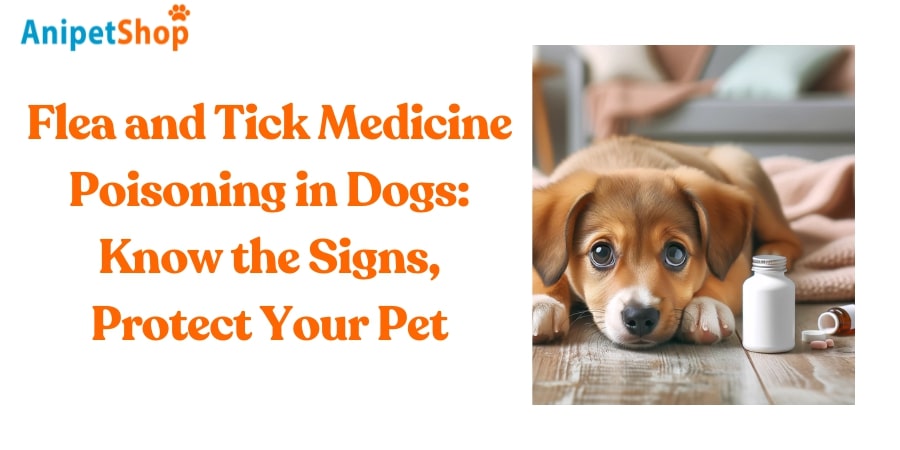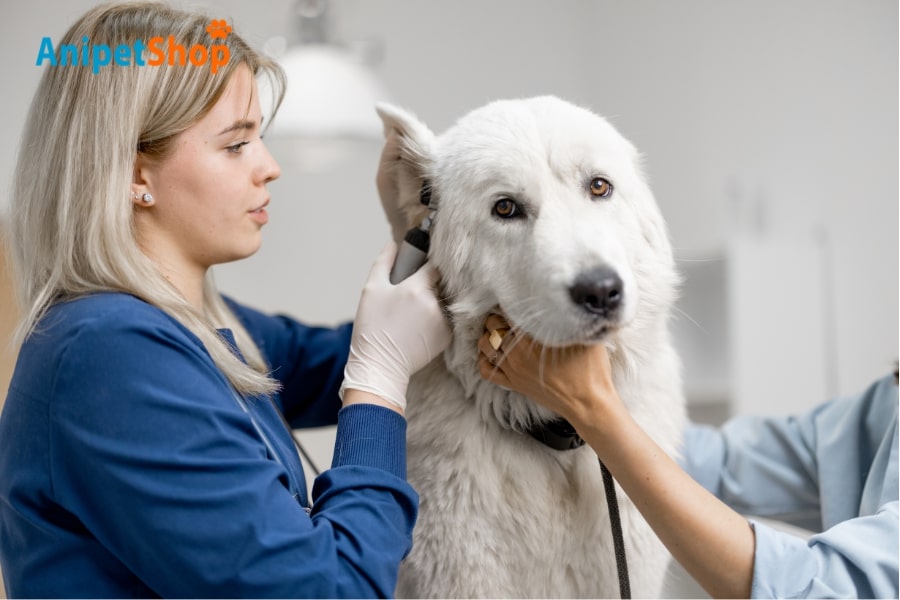Flea and Tick Medicine Poisoning in Dogs
Flea and tick medicine poisoning in dogs happens when they come into contact with harmful levels of these treatments. Pyrethroids and organophosphates, common in these products, can lead to serious health issues. Symptoms include vomiting, diarrhea, drooling, and seizures. Risks often stem from incorrect doses or using products intended for other animals. Immediate veterinary care is crucial, requiring decontamination and symptom management. Pet owners must understand the causes and preventive steps. Gaining more insights into diagnosis and recovery can be beneficial.
Key Takeaways
- Flea and tick medicine poisoning in dogs can result from misuse, such as incorrect dosing or using products meant for other animals.
- Signs of poisoning include vomiting, diarrhea, tremors, agitation, seizures, and trouble breathing.
- Diagnosis involves clinical observation, treatment assessment, physical exams, and tests to check organ function.
- Treatment includes decontamination, symptom management, and constant monitoring of vital signs during recovery.
- Prevent poisoning by consulting a vet, following dosage instructions, and educating owners on recognizing symptoms.

What Is Flea and Tick Medicine Poisoning in Dogs?
Flea and tick medicine poisoning in dogs occurs when these pets are exposed to toxic levels of flea and tick treatments, which often contain chemicals like pyrethroids, organophosphates, or carbamates. These medications are designed to kill parasites, but improper use or adverse reactions can lead to poisoning. The risk is higher when products intended for dogs are mistakenly applied to other animals, such as cats, or when dosages exceed recommended levels. Additionally, certain dog breeds may be more sensitive to specific ingredients, increasing the likelihood of toxicity.
Dogs can ingest toxic substances by licking their fur after topical treatments, consuming leftover pesticides, or through environmental exposure, such as contaminated surfaces or bedding. Symptoms of poisoning can escalate rapidly, leading to severe health complications. Factors like a dog’s age, weight, and overall health also influence their susceptibility to these toxic effects.
The active ingredients in flea and tick treatments, while effective against parasites, can pose significant risks if not used correctly. Pyrethroids, commonly found in over-the-counter flea and tick treatments, are particularly dangerous when used inappropriately. Organophosphates and carbamates, often found in older or less commonly used products, can also be highly toxic. Misuse of these substances, especially in smaller or more sensitive breeds, can result in acute toxicity.
Environmental factors also play a crucial role in the risk of poisoning. Dogs that come into contact with contaminated areas, such as treated lawns or furniture, may absorb these chemicals through their skin or ingest them orally. This can lead to symptoms such as vomiting, diarrhea, drooling, tremors, seizures, or even death if not treated promptly.
Symptoms of Flea and Tick Medicine Poisoning in Dogs
Flea and tick medicine poisoning in dogs can manifest in various symptoms across different systems of the body. Here’s how the symptoms are categorized and arranged within the context:
Skin Effects
- Irritation and Redness: Dogs may experience skin irritation at the application site, leading to redness, hair loss, and future scarring.
- Scratching/Intense Itchiness: This can cause the dog to scratch excessively, roll around on its back, or try to bite the area where the medication was applied.
Stomach or Intestinal Problems
- Vomiting: This is a common symptom indicating that the dog may have ingested or reacted adversely to the medication.
- Diarrhea: Diarrhea often accompanies vomiting as the body tries to expel the toxin.
- Lack of Appetite: Affected dogs might refuse food due to nausea.
- Gagging or Hacking: This can occur as a response to gastrointestinal distress.
- Drooling: Excessive drooling can be a sign of nausea or irritation in the mouth or throat.
Nervous System Effects
- Trembling and Muscle Tremors: These are early signs of nervous system involvement.
- Restlessness and Agitation: Dogs may appear restless or agitated due to discomfort or pain.
- Difficulty Standing or Walking and Weakness: As the condition progresses, dogs may struggle to stand or walk.
- Seizures: Severe poisoning can lead to seizures, indicating significant nervous system disruption.
- Depressed Appearance and Vocalization: Dogs may show signs of depression, including a subdued demeanor and vocalizations such as crying or whimpering, due to discomfort or pain.
- Death: In extreme cases, without prompt treatment, poisoning can lead to death.
If you suspect your dog is experiencing toxic side effects from ingesting or absorbing pyrethrins, pyrethroids, or isoxazolines, it is crucial to seek immediate help. Contact your veterinarian or the Pet Poison Helpline for urgent treatment guidance. Quick action can be life-saving. Depending on the severity of symptoms, such as seizures, difficulty standing, or severe vomiting, you may need to take your dog to an emergency veterinary clinic right away to ensure they receive the care they need.

Causes of Flea and Tick Medicine Poisoning in Dogs
Poisoning from flea and tick products in dogs is primarily caused by exposure to chemicals such as pyrethroids and organophosphates found in these treatments. Besides, flea and tick medicine poisoning in dogs often arises from improper use, such as incorrect dosing or application methods. Ingredients like permethrin are especially dangerous for dogs and can cause severe health issues.
The application method also plays a crucial role. Topical products can lead to overdosing if applied on broken skin or if multiple doses are given too quickly. If the medication isn’t allowed to dry properly before the dog swims or plays, its effectiveness can drop, leading owners to reapply it more often than necessary.
Accidental ingestion is another common problem. Dogs might lick the application site or ingest leftover products from their owner’s hands. Misuse of flea and tick collars, such as cutting them to fit smaller dogs, can also lead to toxic exposure if the dose is altered. Furthermore, not understanding a dog’s specific needs and sensitivities can result in choosing the wrong product, increasing the risk of poisoning. Education on the safe use of these medications is crucial to prevent such incidents.

Diagnosis of Tick Medicine Poisoning in Dogs
Diagnosing tick medicine poisoning in dogs involves a detailed approach. It starts with recognizing recent exposure to tick treatments such as topical applications, oral medications, collars and gathering comprehensive information about the product used, its dosage, and administration timing from the owner.
Clinical signs of poisoning can vary depending on the medication’s active ingredients but commonly include excessive drooling, vomiting, diarrhea, lethargy, tremors, seizures, and respiratory distress in severe cases. A thorough physical examination helps rule out other potential causes and assesses the severity of the condition.
Veterinarians may conduct blood tests to evaluate organ function and check for metabolic imbalances. Urinalysis or imaging studies might be required for additional clarity. Toxicology reports can provide valuable insights, especially when the specific substance is unidentified. Early and accurate diagnosis is crucial for effective treatment and better prognosis, emphasizing the need for prompt recognition and intervention in cases of tick medicine poisoning.
Treatment of Flea and Tick Medicine Poisoning in Dogs
If you suspect your pet has had an adverse reaction to a flea and tick product, promptly refer to the precautionary statement on the product label and consult your veterinarian. Immediately bathe your pet with mild soap and rinse thoroughly with water to remove any residual product. If your pet has ingested the product, rinse their mouth with copious amounts of water, using a garden hose if necessary to flush out toxins.
For pets exhibiting neurological symptoms, hospitalization may be required to manage and mitigate these effects, potentially over several days. Your veterinarian will likely monitor vital signs such as temperature, blood sugar levels, and kidney function, as toxicity can impact these parameters. A physical examination is crucial to rule out other toxins and to assess the situation. Detailed information from you about the exposure and symptoms will guide the diagnosis. In severe cases, additional diagnostic tests like blood work and x-rays may be necessary to determine the extent of the poisoning and appropriate treatment.

Recovery of Tick Medicine Poisoning in Dogs
Recovery from tick medicine poisoning in dogs has a high likelihood of success if prompt treatment is administered and no severe side effects occur. After treatment, your dog will need to be closely monitored over the next few days to ensure that no significant damage has occurred. It’s common for drooling to persist for several days following treatment; this is a normal side effect and should not cause alarm.
However, if your dog continues to experience adverse health effects, it is advisable to discontinue the use of the medication immediately. In such cases, collaborating with your veterinarian to identify a safer tick prevention treatment is crucial. Always ensure that you follow the administration instructions carefully and store all products securely out of your pet’s reach when not in use. This approach will help minimize risks and ensure your dog’s safety and well-being during the recovery process.
Prevention of Flea and Tick Medicine Poisoning in Dogs
Ensuring the safety of your dog from flea and tick medicine poisoning involves a proactive and careful approach. Here are four essential strategies:
- Consult Your Veterinarian: Before using any flea or tick treatment, consult your vet. They can recommend the best product based on your dog’s age, weight, health, and local pest types.
- Follow Dosage Instructions: Stick strictly to dosage guidelines. Overdosing can cause severe health issues, while underdosing might not control pests effectively.
- Monitor for Adverse Reactions: After applying the treatment, watch your dog for signs of reactions like vomiting, lethargy, or skin irritation. Report any symptoms to your vet immediately for prompt treatment.
- Store Products Safely: Keep flea and tick medications out of reach of pets and children. Proper storage prevents accidental ingestion and ensures treatments remain effective.

Frequently Asked Questions
Can Flea and Tick Medicine Poisoning Be Fatal for Dogs?
Flea and tick medication can pose significant health risks to dogs, depending on the dosage and the product used. In severe cases, poisoning may lead to fatal outcomes, requiring immediate veterinary care.
How Can I Safely Store Flea and Tick Medications?
To store flea and tick medications safely, keep them in their original packaging, away from sunlight and moisture. Ensure they are inaccessible to children and pets, and maintain a cool, stable temperature.
Are Certain Dog Breeds More Susceptible to Poisoning?
Certain dog breeds show different sensitivities to toxins. This variance arises from genetic factors, metabolic differences, and size. Breeds with health issues or lower body weight may be more prone to poisoning.
What Should I Do if I Miss a Dose?
If you miss a dose, give it as soon as you remember. If the next scheduled dose is soon, skip the missed one and return to the regular schedule. If unsure, consult your veterinarian.
Can Other Pets Be Affected by Flea and Tick Medicine?
Flea and tick medications can impact other pets in the home if ingested or misapplied. Follow the product instructions carefully and speak with a veterinarian about any specific concerns in multi-pet households.
Conclusion
Flea and tick medicine poisoning in dogs can be dangerous, demanding swift action. Symptoms often include neurological and digestive issues. Diagnosis hinges on a detailed history and clinical assessment. Treatment varies based on poisoning severity and may include decontamination and supportive care. Preventing such incidents involves proper medication use and storage. Educating pet owners about these products will reduce poisoning cases further.
References:
-
Wanzalow, J., Linek, M., Kruedewagen, E. M., & McGregor, I. S. (2011). Spinosad and permethrin for the treatment and prevention of flea infestations in dogs: A randomized, blinded, controlled study. Veterinary Parasitology, 176(2-4), 357–361. https://doi.org/10.1016/j.vetpar.2010.11.018
-
U.S. Food and Drug Administration. (2018, September 19). Fact sheet for pet owners and veterinarians about potential adverse events associated with isoxazoline flea and tick products. https://www.fda.gov/animal-veterinary/animal-health-literacy/fact-sheet-pet-owners-and-veterinarians-about-potential-adverse-events-associated-isoxazoline-flea
-
Imperial College London. (2022, February 1). Toxic flea and tick treatments polluting UK rivers at levels harmful to wildlife. https://www.imperial.ac.uk/news/243875/toxic-flea-tick-treatments-polluting-uk/
Lily Watson is an author specializing in veterinary care in Australia. With a profound passion for animal welfare and a solid foundation in veterinary science, Lily has dedicated herself to disseminating valuable knowledge and information for both pet owners and professionals in this field.

